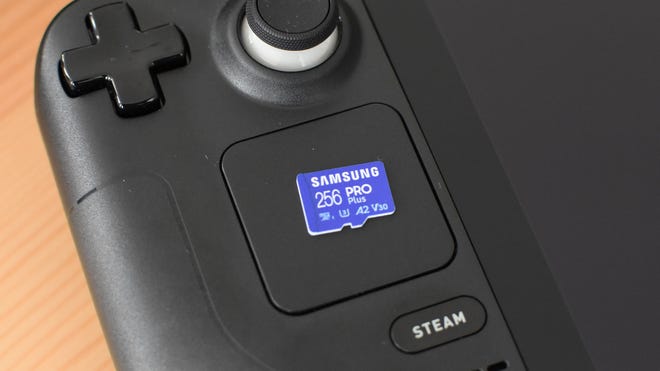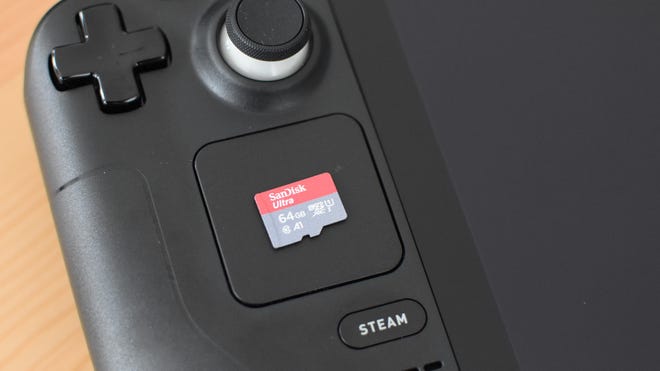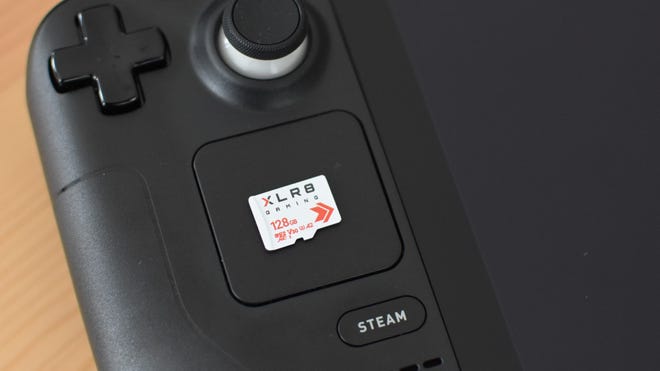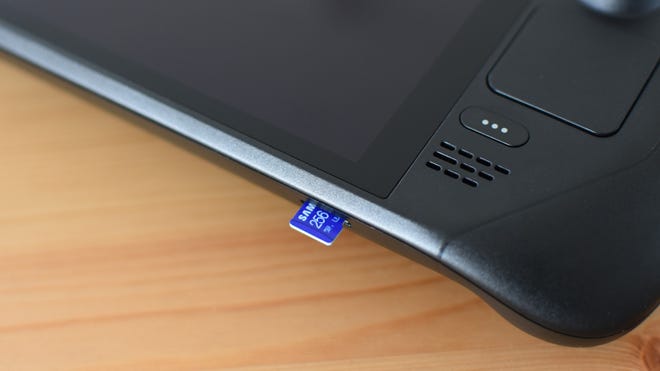The best microSD cards for the Steam Deck
Expand your Steam Deck’s storage with these tried-and-tested cards
The best microSD cards for the Steam Deck have been largely unchanged for most of the Valve’s handheld life – maybe they’re just that good? Not that there’s a million new storage cards vying for attention every week, but at least you can have yourself one of these tried, tested, and trusted microSDs without the fear of imminent planned obsolescence. In fact, they’re pretty much the first accessory any new owner should add to their portable PC, ahead of even the best Steam Deck cases and docking stations.
That’s because, unless you’ve treated yourself to a 1TB Steam Deck OLED (and maybe even then), the onboard SSD can fill up very, very quickly. Modern games are more storage-hungry than ever before, leaving the 64GB and 256GB models especially prone to running out of space. Cracking open your Deck and replacing the SSD is an option, but a relatively risky one, and simply slotting in a microSD card is just easier. Potentially cheaper, too.
You might not even be losing out much on performance. I’ve tested all the microSD cards here with a variety of load time tests in Shadow of the Tomb Raider and Aperture Desk Job, and the fastest ones are very nearly as quick as the Steam Deck’s stock 512GB SSD. Not bad going, for such teensy slivers of storage hardware.
If you’re happy, however, to trade speed for affordability, there are some excellent cheap microSD cards here as well, with capacities ranging from a mere 32GB up to an OLED-beating 1.5TB. As with buying a new desktop SSD, try to secure yourself as much space as your budget allows, lest you end up having to either uninstall games before your time, or come back here in search of a second card. I mean, you'd be welcome to, but measure twice cut once, y'know?
Finally, before we get into the list proper, I should share a rare bit of microSD news from SandDisk, who make some of the top cards you’ll find below: they actually do have some new models coming in the summer, including the high-performance SanDisk microSD Express and a 2TB version of the SanDisk Extreme Pro. 2TB microSDs are exceedingly rare and push the very limit what the Steam Deck supports, so that could be one to hold out if you want the best of the best – though it’s not set to launch until sometime in Summer 2024. Just fyi.
Otherwise, read on for the full list of my top Steam Deck microSD card picks. For more on getting the most out of your SteamOS handheld, may I also suggest a visit to our Steam Deck Academy, which is full of handy guides on everything from stretching the Steam Deck’s battery life to installing non-Steam launchers like Lutris.
Best microSD cards for the Steam Deck
- Samsung Pro Plus - The best microSD card for the Steam Deck overall
- SanDisk Extreme Pro - The fastest microSD card for the Steam Deck
- SanDisk Ultra - The best cheap microSD card for the Steam Deck
- Kingston Canvas Go! Plus - Good speeds with a wide range of capacities
- PNY XLR8 microSDXC Gaming – A fast, affordable alternative to the SanDisk Ultra
- Samsung Evo Select - Varied performance, but super cheap
Samsung Pro Plus
The best microSD card for the Steam Deck overall

Samsung have crafted some of the finest PC SSDs (the 870 Evo, the 870 Qvo, the 990 Pro and so on), so it’s not terribly surprising they know their way around a brilliant microSD card for the Steam Deck as well. The Samsung Pro Plus was the first card I tested to get under 11s in the Aperture Desk Job launch test, as well as the first to hit 16s dead in the Shadow of the Tomb Raider loading test. The SanDisk Extreme Pro has since posted even faster load times, but Samsung's microSD has a generally better balance of price and performance.
That's not the same as it being cheap per se, especially compared to the SanDisk Ultra, but generally it’s only a few quids’ / bucks’ difference. And the 512GB model, the most spacious available, is actually a quite a lot more affordable than the similarly-specced Kingston Canvas Go! Plus.
- Aperture Desk Job average launch time: 10.9s
- Aperture Desk Job average load time: 3.4s
- Shadow of the Tomb Raider average launch time: 14.6s
- Shadow of the Tomb Raider load time: 16s
SanDisk Extreme Pro
The fastest microSD card for the Steam Deck
Even if it’s just by fractions of a second, the SanDisk Extreme Pro has the honour of being the only microSD card here to consistently outspeed the 512GB Steam Deck’s SSD: its 15.6s time in the Shadow of the Tomb Raider game loading test just noses past the SSD’s 15.9s. Should you mainly care about shaving off every possible half-second from your game loading times on the Steam Deck, then the Extreme Pro is the card to go for.
The only reason it’s not at the very top of this list is that the Samsung Pro Plus, which is also quick off the mark, tends to be more attractively priced. That said, some of the Extreme Pro’s capacities – like the 512GB version – are more on par with the Pro Plus in the UK, in which case it’s an excellent alternative. SanDisk’s microSD card also has a wider range of size options than most, including a spacious (if very pricey) 1TB model.
- Aperture Desk Job average launch time: 10.3s
- Aperture Desk Job average load time: 3.3s
- Shadow of the Tomb Raider average launch time: 14.3s
- Shadow of the Tomb Raider load time: 15.6s
SanDisk Ultra
The best cheap microSD card for the Steam Deck

The SanDisk Ultra offers a wider range of capacities than the Pro Plus, with lower prices across the board. This is partly owing to its lower U1 speed class, meaning its write speeds aren’t as fast as U3 models, but that’s more of a concern for videographers needing a microSD card for their camera. Where games performance is concerned, read speed is king, and the affordable Ultra can keep pace with pricier cards.
It put up an especially spry challenge in Aperture Desk Job, and even its 'worst' performance – the Shadow of the Tomb Raider load test – was less than half a second slower than the Deck’s top-spec SSD. That said, I’d recommend going for a bigger capacity than the 64GB card I used for testing; the 256GB and 512GB models are both particularly good deals at their current prices, and the 1TB version is a bargain compared to the 1TB SanDisk Extreme Pro. The SanDisk Ultra also has the exceedingly rare quality of a 1.5TB option, which is as much microSD storage as your Steam Deck can possibly get.
- Aperture Desk Job average launch time: 11.1s
- Aperture Desk Job average load time: 3.4s
- Shadow of the Tomb Raider average launch time: 14.8s
- Shadow of the Tomb Raider load time: 16.3s
Kingston Canvas Go! Plus
Good speeds with a wide range of capacities

According to its marketing prose, the Kingston Canvas Go! Plus is for "adventurers." Is playing God of War on the 11:55 Paddington to Swindon service an adventure? Either way, this microSD card proves it can suit the Steam Deck just as well as a GoPro, with a particularly zippy average time in the Shadow of the Tomb Raider launch test.
Outside of lacking a 1TB option, there’s also a wider selection of capacities than with the Samsung Pro Plus, or the PNY XLR8 below. The Canvas Go Exclamation Mark Plus’ 512GB model is currently more expensive than its peers, and the 256GB model no longer provides big savings over the Pro Plus, but they're all still decently priced for the performance.
- Aperture Desk Job average launch time: 11.3s
- Aperture Desk Job average load time: 3.5s
- Shadow of the Tomb Raider average launch time: 14.8s
- Shadow of the Tomb Raider load time: 16.3s
PNY XLR8 microSDXC Gaming
A fast, affordable alternative to the SanDisk Ultra

A rare games-focused card, the PNY XLR8 microSDXC Gaming put up respectable times in all four speed tests without any cheeky price premiums. In fact, for sheer affordability, the XLR8 is either a few pounds less or just a little more than the equivalent SanDisk Ultra capacity. And that’s while offering class U3 write speeds, which might be helpful if you’re planning to use the Steam Deck as a desktop PC even if they’re not as useful to gaming specifically.
After months of largely being a US-favoured proposition, all three varieties of the XLR8 are now easily available in the UK as well. The SanDisk Ultra has the advantage of a wider capacity range, including a 1TB model, but otherwise there's very little between these two microSD cards on price or Steam Deck performance.
- Aperture Desk Job average launch time: 11.2s
- Aperture Desk Job average load time: 3.5s
- Shadow of the Tomb Raider average launch time: 14.8s
- Shadow of the Tomb Raider load time: 16.1s
Samsung Evo Select
Varied performance, but super cheap
The Samsung Evo Select looks like a tasty microSD bargain: as I’m writing this it’s even cheaper than the SanDisk Ultra, despite its higher specs, and its performance in our Aperture Desk Job benchmarks was only behind the elite Samsung Pro Plus and SanDisk Extreme Pro. If you felt the sting of the Steam Deck itself in your finances, this kind of affordability will feel like a soothing aloe balm.
It’s only a disappointing result in the Shadow of the Tomb Raider loading test that denies the Evo Select a higher position in this list, though to be fair, its launching speed for the same game is much more competitive with the pricier stuff. It’s still a good bet for those wanting a budget microSD specifically.
- Aperture Desk Job average launch time: 10.7s
- Aperture Desk Job average load time: 3.3s
- Shadow of the Tomb Raider average launch time: 14.7s
- Shadow of the Tomb Raider load time: 20.4s
The best microSD cards for the Steam Deck: FAQ
What microSD cards are compatible with the Steam Deck?
The Steam Deck’s microSD requirements aren’t very demanding. Any UHS-I microSD should work, including microSDXC (Expanded Capacity) and microSDHC (High Capacity) cards. You’re best off looking at SDXC cards, though, like the ones listed above: standard microSD cards are limited to a piddly 2GB, while microSDHC cards max out at 32GB. Since only microSDXC cards can therefore occupy the 64GB-2TB range, they’re the ones to focus on to make sure you’re adding sufficient space.

Once you’ve got a compatible microSD card, it’s just a case of pushing it into the slot on the bottom edge of the Steam Deck until it clicks into place, then going into the SteamOS System settings to format it. From there, you can set it as the default game installation location in the Storage settings. To remove the microSD card, push it even further into the slot until the lock releases, sending it popping partway out.
Do I need to format my Steam Deck’s microSD card?
Probably, as microSDs normally don’t come ready-to-use on a Linux system like the Steam Deck. Luckily, formatting the microSD card yourself is easy. Just slide it into the port on the Deck’s bottom edge, power it on, then navigate to the System section of the main Settings menu. Scroll down to 'Format SD Card', hit the Format button, and in a few moments your card will be set up and ready to roll.
Is there any performance difference between installing games on a microSD card or on the Steam Deck’s SSD?
In most games, the only tangible difference is in load times; you won’t get slower framerates on a microSD card, for example. The only games that might not work as well as they do on the SSD are those that specifically take advantage of high SSD speeds, like Cyberpunk 2077’s open world streaming and Ratchet & Clank: Rift Apart’s dimension-hopping sequences. In the latter’s case, the game essentially sits on a loop for a few seconds so the game can load in the new scene from the microSD card, a transition that’s more or less instantaneous on an SSD.
To be clear, though, these examples are extremely rare. The only other egregious example I can think of is Starfield, which needs an SSD even on a beefy desktop PC. And that won’t run at acceptable framerates on the Steam Deck’s APU anyway, so storage is a moot point. The vast majority of your library should run just fine off a microSD.
Can I set a microSD card as my Steam Deck’s default drive?
Yep! In the main Settings menu, scroll down to the Storage section, then highlight the microSD card and press the X button to set it as the default installation location.
In this same sub-menu, you can also move games between the internal drive and the microSD. Select the game you want to move, press the Y button, make sure the other drive is selected in the drop-down menu, and finally hit 'Move' to transfer it over.
What do microSD interfaces and speed classes mean?
UHS (Ultra High Speed) is the current interface standard for SD and microSD cards, with specific ratings like UHS-I, UHS-II, and UHS-III denoting maximum transfer speeds. UHS-I cards have a max speed of 104MB/s, while UHS-II and UHS-III can reach 312MB/s and 624MB/s respectively.
On the Steam Deck, Valve opted for the UHS-I interface. UHS-II and UHS-III cards are backwards compatible with UHS-I, so you could use them in the Deck, but you’d be limited to UHS-I speeds; as such, theres’s little point in spending more to get the newer interfaces. Besides, game launching and loading times depend on non-sequential read speeds, which normally don’t come close to the advertised maximum sequential speeds anyway.
(For what it's worth, UHS-II and UHS-III microSD slots are likewise backwards compatible with UHS-I microSD cards, which is why you can use any of the cards listed above with the UHS-II-equipped Asus ROG Ally. If, hypothetically, you wanted to ditch your Steam Deck in favour of Asus' more powerful handheld, any microSD card you bought for the former would still work in the latter.)
Another spec you might see printed on microSD cards is the speed class, like U1 or U3. Rather than general maximum speeds, these represent minimum sequential write speeds: U1 is 10MB/s, U3 is 30MB/s. Again, these ratings don’t have any real bearing on how fast your Steam Deck games will load, though it might be worth plumping for a U3 card if you’re using your Deck as a full-on desktop replacement, where faster write speeds will come in handy more often.









